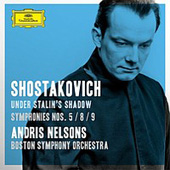

Tremendously intense and commited playing by the Boston Symphony Orchestra musicians, deeply insightful and vigorously animated readings by conductor Andris Nelsons,
impactful audio captured by the DG recording engineers, and a rousing release of pent-up energy from the cheering audience at the conclusion of the 5th symphony, all add up to make this release
one of the best Shostakovich recordings in a long time. It's the next in line after the release of an outstanding account of the Symphony No. 10 (reviewed here)
in a projected cycle of all the symphonies.
We all have the Soviet regime under Stalin to thank for instilling a deep fear in Shostakovich during the 1930s, a fear strong enough for him to postpone public performances of his Fourth
Symphony, and instead regroup and focus all of his efforts on his more congenial, if somewhat sardonic, Symphony No. 5 in D minor, Op. 47. In my opinion one
of the best symphonies of the 20th century. I've always admired composers who can take a very simple idea, a very rudimentary motif, and through clever manipulation, use it to build a complete movement, if not a whole
symphony. The opening two note ascending harmonic leap of this symphony is a prime example. It's used in various guises as building blocks of the first movement until it returns as a kind of duet
for flute and horn at the 12:50 mark where it completely transfigures the mood, and totally uplifts the overall character of the symphony. It's one of those rare 'coup de génie' moments in music.
And also the way it is used in the lower bass strings during the final minute to bring the movement to a close is quite moving. Apart from some of Gustav Mahler's symphonies, I don't think any
other 20th century symphonies contain as beautiful and intensely moving a slow movement as the Largo of this work. And Andris Nelsons gets the most expression possible out of
the BSO strings, from the faintest shimmer to the loudest cries of despair, and they deliver with a sonorous, ardent sound. Nelsons is part of a small group of conductors who have opted to drastically
slow down the final pages of the last movement, a viewpoint I've personally never warmed up to in the past, but this time it seems to hit the mark, as echoed by the instantaneous cheers of approval
and bedazzlement form the audience as soon as the last note is struck.
The Symphony No. 8 in C minor, Op. 65 composed in 1943, which along with the Seventh, is considered a 'wartime' symphony, has always been overshadowed by the
overwhelming international acclaim No. 7 garnered over the years. But that's because these two works shouldn't be judged using the same criteria. The 7th deals with the physical, violent, real-life impact
of the atrocity and enormity of war, whereas the 8th reveals the emotional and psychological damage and detritus left behind by the brutality of it all, especially when inflicted by your own side.
Here again Andris Nelsons summons up a fiercely intense and expressive account of it all, from the dark desolation of the first movement, to the ear-shattering brutality of the "war machine"
middle movement (stupefying bass drum), to the abnormally mysterious ending. All played to the hilt by the BSO.
A wise choice on the part of the decision makers at Deutsche Grammophon to insert the Symphony No. 9 in E flat major, Op. 70 first on the recording
as opposed to last because due to its relatively light and somewhat humorous nature it would have broken No. 8's emotional impact. Nonetheless, I can't remember the last time I heard such an
animated account of this short symphony, packed full with all of Shostakovich's idiosyncrasies.
Jean-Yves Duperron - July 2016